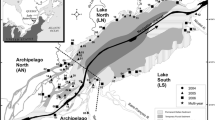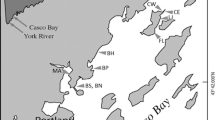Abstract
The northern Everglades (Water Conservation Area 2A) annually receives an excess addition of 60M tons of phosphorus and 1814 M tons of nitrogen from agricultural run-off. During 1990–91, invertebrates were collected from replicate sweep and core samples at eight sites along the nutrient enrichment gradient in Water Conservation Area 2A (WCA-2A). Species richness, Shannon’s diversity, the number of unique species, and the density of invertebrates and small fish were all greater within enriched and intermediately enriched open water habitats than unenriched sloughs. Sorenson’s taxonomic similarity index was significantly different between enriched and unenriched areas. Ostracods in particular were 14 times more abundant in the enriched area than at unenriched sites. The freshwater shrimp (Palaemonetes paludosus) was the only common species with lower densities in enriched than unenriched areas. However, the trophic structure or percent composition of grazers, predators, and collector-gatherers and the number of species within taxonomic orders and functional feeding groups was very similar among sites along the nutrient enrichment gradient. Higher invertebrate and small fish diversity and density within enriched sites indicates that nutrient enrichment has not caused direct harmful foodweb effects that may adversely influence higher trophic levels (e.g., wading birds). Assuming, however, that nutrients can cause cattails to overgrow and eliminate sloughs, the centers of biological diversity in the Everglades, then nutrient enrichment may have harmful indirect effects.
Similar content being viewed by others
Literature Cited
Barber, E. 1991. We need a balancing act. National Wetlands Newsletter 13:5–6.
Campbell-Mohn, C. 1991. Will it save the Everglades? National Wetlands Newsletter 13:4.
Cheal, F., J. A. Davis, J. E. Growns, J. S. Bradley, and F. H. Whittles. 1993. The influence of sampling method on the classification of wetland macroinvertebrate communities. Hydrobiologia 257:47–56.
Craft, C. B. and C. J. Richardson. 1993. Peat accretion and N, P, and organic accumulation in nutrient-enriched and unenriched Everglades peatlands. Ecological Applications 3:446–458.
Davis, S. M. 1989. Sawgrass and cattail production in relation to nutrient supply in the Everglades. p. 325–341.In R. R. Sharitz and J. W. Gibbons (eds.) Freshwater Wetlands and Wildlife. CONF-8603101, DOE Symposium series no. 61, USDOE Office of Scientific and Technical Information, Oak Ridge, TN, USA.
Davis, S. M. 1994. Phosphorus inputs and vegetation sensitivity in the Everglades. p. 357–378.In S. M. Davis and J. C. Ogden (eds.) Everglades: The Ecosystem and Its Restoration. St. Lucie Press, Delray Beach, FL, USA.
Epler, J. H. 1992. Identification manual for the larval Chironomidae (Diptera) of Florida. Biology Section, Florida Department of Environmental Regulation, Tallahassee, FL, USA.
Gleason, P. J. (ed.). 1974. Environments of South Florida: Present and Past. Miami Geological Society, Miami, FL, USA.
Gleason, P. J. and W. Spackman, Jr. 1974. Calcareous periphyton and water chemistry in the Everglades. p. 146–181.In P. J. Gleason (ed.) Environments of South Florida, Present and Past. Miami Geological Society, Miami, FL, USA.
Hutcheson, K. 1970. A test for comparing diversities based on the Shannon formula. Journal of Theoretical Biology 29:151–154.
Kushlan, J. A. 1974. Effects of a natural fish kill on the water quality, plankton, and fish population of a pond in the Big Cypress Swamp, Florida. Transactions of the American Fisheries Society 103:235–243.
Kushlan, J. A. 1975. Population changes of the apple snail (Pomacea paludosa) in the southern Everglades. Nautilus 89:21–23.
Kushlan, J. A. 1979. Temperature and oxygen in an Everglades alligator pond. Hydrobiologia 67:267–271.
Kushlan, J. A. and M. S. Kushlan. 1979. Observations on crayfish in the Everglades, Florida. Crustaceana supplement 5:115–120.
Kushlan, J. A. and M. S. Kushlan. 1980. Population fluctuations of the prawn,Paleamonetes paludosus, in the Everglades. American Midland Naturalist 103:401–403.
Kushlan, J. A., S. A. Voorhees, W. F. Loftus, and P. C. Frohring. 1986. Length, mass, and calorific relationships of Everglades animals. Florida Scientist 49:65–80.
Loftus, W. F., J. D. Chapman, and R. Conrow. 1986. Hydroperiod effects on Everglades marsh food webs, with relation to marsh restoration efforts. Proceedings of the Fourth Triennial Conference on Science in the National Parks. Fort Collins, CO, USA.
Magurran, A. E. 1988. Ecological Diversity and Its Measurement. Princeton University Press, Princeton, NJ, USA.
Mason, C. F. 1991. Biology of Freshwater Pollution (2nd Edition). John Wiley & Sons, New York, NY, USA.
Merritt, R. W. and K. W. Cummins (eds.) 1984. An Introduction to the Aquatic Insects of North America (2nd Edition). Kendall/Hunt, Dubuque, IA, USA.
Moore, J. C., P. C. de Ruiter, and H. W. Hunt. 1993. Influence of productivity on the stability of real and model ecosystems. Science 261:906–908.
Pennak, R. W. 1989. Freshwater Invertebrates of the United States (3rd Edition). John Wiley & Sons, New York, NY, USA.
Qualls, R. G. and C. J. Richardson.; 1991. Water chemistry along a nutrient enrichment gradient in the northern Everglades of Florida. p. 10–79.In C. J. Richardson (ed.) Effects of nutrient loadings and hydroperiod alterations on control of cattail expansion, community structure, and nutrient retention in the water conservation areas of south Florida. Annual Report to Everglades Area Environmental Protection District, Belle Glade, FL, USA.
Rader, R. B. 1994. Macroinvertebrates of the northern Everglades: species composition and trophic structure. Florida Scientist 57: 22–33.
Rader, R. B. and C. J. Richardson. 1992. The effects of nutrient enrichment on algae and macroinvertebrates in the Everglades: A review. Wetlands 12:121–135.
Robertson, W. B. and J. A. Kushlan. 1984. The southern Florida avifauna. p. 219–257.In P. J. Gleason (ed.) Environments of South Florida: Present and Past. Miami Geological Society, Miami, FL, USA.
Scheidt, D. J., M. D. Flora, and D. R. Walker. 1989. Water quality management for Everglades National Park. p. 377–390.In Wetlands: Concerns and Successes. American Water Resources, Association, Bethesda, MD, USA.
SFWMD (South Florida Water Management District). 1992. Surface Water Improvement and Management Plan for The Everglades, Volume III. Technical Report. SFWMD, West Palm Beach, FL, USA.
Shannon, C. E. and W. Weaver. 1963. The Mathematical Theory of Communication. University of Illinois Press, Urbana, IL, USA.
Simberloff, D. S. 1974. Equilibrium theory of island biogeography and ecology. Annual Review of Ecology and Systematics 5:161–182.
Wetzel, R. G. 1983. Limnology (second edition). W. B. Sanders Co., Philadelphia, PA, USA.
Zar, J. H. 1984. Biostatistical Analysis (second edition). Prentice-Hall Inc. Englewood Cliffs, NJ, USA.
Author information
Authors and Affiliations
Rights and permissions
About this article
Cite this article
Rader, R.B., Richardson, C.J. Response of macroinvertebrates and small fish to nutrient enrichment in the northern Everglades. Wetlands 14, 134–146 (1994). https://doi.org/10.1007/BF03160629
Received:
Revised:
Accepted:
Issue Date:
DOI: https://doi.org/10.1007/BF03160629




